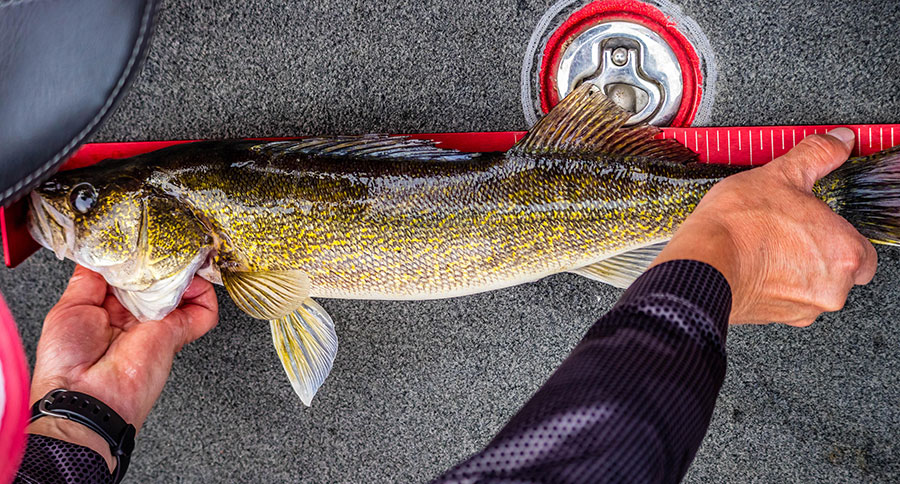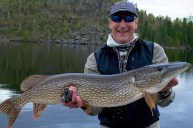The walleye is one of our favorite fish to catch and eat. Let's review what they are, where they live, and how to fish for them.
The walleye is the largest member of the perch family, and is held in high regard by many anglers. A native North American species, the walleye is sometimes called a yellow pike or perch pike. The most ardent walleye-loving fishermen prefer names like "Old Marble Eyes," "Walters," or the silly-sounding "gravel lizards."
The scientific name of Sander vitreus may sound similar to its close cousin, the European Zander, but walleye fishing enthusiasts everywhere understand the difference. In areas where the fishery can be tremendous, such as the St, Lawrence River, an adult walleye can regularly reach lengths of 30 inches and weights of up to 18 pounds. According to the IGFA, the all-tackle world record still stands to this day at 25 pounds, which was caught in Old Hickory Lake, Tennessee in 1960.
Walleye are known for their sharp teeth and odd-looking eyes, both of which help their ability to hunt prey under low light conditions. They tend to feed more extensively at dawn and dusk, but are right at home feeding during the night hours.
Walleye Distribution
They are mostly a widespread species in the colder waters of Canada and the northern United States, but they are found as far south as Arkansas, which is a hotbed for walleye angling due to its best known fishery, Greers Ferry Lake in the north-central part of the Natural State.
According to the U.S. Fish & Wildlife Service, "Walleye in North America are found in the Arctic south to the Great Lakes and across to the St. Lawrence River. In Canada, walleye are found in Quebec across to the Northwest Territories. Within the United States, walleye are found southward into Alabama and Arkansas and in the Mississippi River basin. Walleye have been widely introduced outside of their native range within the U.S., including the Atlantic and Pacific Ocean drainages and in the Gulf of Mexico."
In other words, they aren't everywhere, but they're found in a lot of accessible places.
As anglers, we know they haunt some of our favorite lakes and rivers, largely including Lake of the Woods, which occupies parts of the Canadian provinces of Ontario and Manitoba and the state of Minnesota. Other reputable areas include Lake Mille Lacs, Lake Erie, Bay of Quinte, and the Columbia River in Oregon, just to name a few.
Reproduction and Spawning Habits of Walleye
Spawning walleye act a lot like other common species of fish, moving to preferred waters in the spring and . In lakes that have access to large enough tributaries, walleye will run upstream in the months of March and April when water temperatures reach the optimum level, around 45-48 degrees.
A walleye's spawning process occurs in small groups and involves chasing, swimming in a circular pattern, and dorsal fin erection. The spawning group will then move to shallower water, where the females begin to roll on their sides and release their eggs. Males will then immediately release their milt to fertilize the freshly laid spawn.
A large female can lay a whopping 500,000 eggs, which will incubate for about 15-30 days depending on conditions.
Walleye Fishing
Walleye can be a finicky foe sometimes, and can cooperate like gangbusters at other times. Anglers like to use live bait to jig for them, using minnows or leeches. They'll also troll stickbaits and cast crankbaits. I've used jigging spoons and nightcrawler harness rigs, along with crayfish. There's a wide range of baits and lures that walleye will eat. The only thing that we like more than arguing what bait is the best, is arguing over who caught the first, the most, and the biggest.
One of the favorite techniques for walleye anglers everywhere is trolling. As with all styles of walleye fishing, sensitivity is key. For trolling walleye, 10- to 12-pound test fluorocarbon is the usual recommendation, sometimes with a heavier leader as these game fish have sharp teeth.
When I cast for walleye, I use a straight spool of 20/6 Power Pro braid (20-pound test with a six-pound test diameter).
In clear, shallower water, mono is the key, especially in the spring. Monofilament disappears in the water column much better than braid and while it stretches, it often softens the presentation of a jig or other offering.
I've fished in the St. Lawrence River off the head of Carlton Island and boated 11 walleye that were all over 10 pounds, and I've fished tiny Canadian shield lakes (that were barely a mile long and a half mile wide) and caught 24-inch skillet fillers until my arm fell off.
And I loved both.
Walleye populations aren't what they were in some areas, hence there are popular and viable fish hatcheries around the country. More than one Department of Natural Resources devotes effort to watch over the raising of this sport fish in an effort to create an attainable population (and to keep an eye out for the next state record).
This is one of our favorite freshwater fishes, even rivaling the more popular largemouth bass. There are many YouTube channels dedicated to walleye fishing, several pro circuit walleye tours, and just as many anglers looking to prove that they have what it takes to out fish the competition.
Eating Your Walleye Catch
Walleye have a light flesh that is one of the best tasting of all the game fish species. They are as simple to fillet as they are to cook, and with so many recipes you can't go wrong. Some folks like to soak the fillets in saltwater for a while before draining and adding olive oil, lemon juice, and garlic. Then all you need to do is to get it swimming in the skillet and start cooking.
Back in the day, our shore lunch was simply walleye fillets wrapped in aluminum foil with butter, salt, pepper, and onions, right next to another package with potatoes in butter and garlic. Throw it all on an open fire and let the anticipation begin.
There are so many recipes that you could spend a day just looking at them all, but sometimes the simpler the better.
Like with many game fish, the walleye attraction is viable and easy to obtain. The best part is, you'll learn something new each time you target them.
Looking for a little more or even hot lunch for your hunting blind? Follow my webpage, or on Facebook and Twitter.
NEXT: NEW YORK OFFICIALLY HAS A NEW WALLEYE RECORD
WATCH





